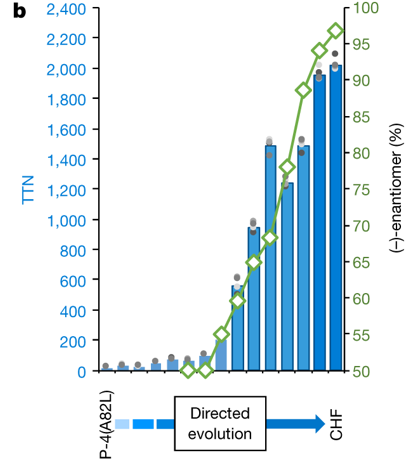Last year, chemical engineer Frances H. Arnold from the California Institute of Technology earned the 2018 Nobel Prize in Chemistry for her pioneering and brilliant work with the directed evolution of enzymes. She became the second female to win the prize in Chemistry.

Figure 1: The flowchart for the directed evolution of enzymes.
Source: Advanced Information. NoblePrize.org. https://www.nobelprize.org/prizes/chemistry/2018/advanced-information/
Enzymes are biological catalysts to promote biochemical reactions in living organisms, and different enzymes specialize in different reactions. When the environment changes, genes mutate, and hence enzymes evolve to help an organism develop desired traits and adapt to the new environment. Although natural enzymes are excellent at doing their job, there are limitations: they only make chemicals that organisms need and only function in water at room temperature. These restrictions narrow the application of enzymes in the chemical and pharmaceutical industries. To tackle these problems, Dr. Arnoldhas used the same strategy as nature does-introduce mutations to existing enzymes-and obtained evolved enzymes which can quickly adapt to unusual environments, i.e., organic solvents, and speed up desired reactions. In the early 1990s, she reported the first case using subtilisin E, a digesting enzyme, to make an enzyme with much higher activity. This well-designed enzyme is 256 times more efficient to function the same reactions than the original enzyme in a polar organic solvent. This work has been seen as the benchmark achievement for the field of directed evolution of enzymes.

Figure 2: Reaction rate of hydrolysis of sAAPF-pna by subtilisin E variants in the solution containing 40% (vol/vol) DMF. Data source: Chen, K.; Arnold, F. H., Proc. Natl. Acad. Sci. USA, 1993, 90, 5681-5622
Dr. Arnold and her colleagues have been devoting to developing a variety of enzymes to deal with different synthetic challenges. For example, written in Nature this year, they describe a new iron-based enzymatic system to activate inert C-H bonds, replacing noble-metal catalysts. As the directed evolution proceeds, the system has a higher total turnover number (TTN) which represents how much product can be made until the catalyst is no longer active. Higher TTN means that the system becomes increasingly active as the enzyme evolves. The evolved enzyme CHF exhibits excellent stereoselectivity which is significant in pharmacology as human bodies react differently to enantiomers.

Figure 3: The bar chart represents the mean total turnover number (TTN) values averaged over four reactions; the grey dots show each TTN; green diamonds demonstrate enantioselectivity data.
Source: https://www.nature.com/articles/s41586-018-0808-5
Another recent pioneering work done by Arnold group is using a natural enzyme to form C-Si bond which is unknown in nature although Silicon is the most abundant element in Earth’s crust. Silicon has extensive applications in chemistry and material science, including pharmaceutical developments and productions of semiconductors, and preparations of silicon-containing molecules, especially organic compounds, usually require multi-step and unsustainable synthetic routes. This innovative and environmentally friendly method offers new avenues of producing organosilicon compounds and opens up more opportunities in pharmaceutical research. These findings also shine the lights on what silicon-based life might look like, which has long been a fantasy in science fictions!

Figure 4: The active environment of the enzymatic system for C-Si bond formation
Source: http://science.sciencemag.org/content/354/6315/1048
Figure 5: Artist rendering of Si-based life form
Source: https://media3.s-nbcnews.com/j/newscms/2017_16/1969741/organosilicon-based-life_c18e68cad6b3bf817a28e03558a7bfba.fit-2000w.jpg
As a winner of the Nobel Prize, Dr. Arnold will encourage more people, especially women, to do science, and inspire more research in biocatalysis. As she pointed out in her essay, using well-functionalized enzymes rather than transition metals as catalysts allows for the development of sustainable chemical and pharmaceutical industries, and hence producing many of chemicals with biocatalysts will be the trend in the near future.
Dr. Arnold’s Nobel Lecture: Innovation by Evolution. Source: YouTube
References
Directed evolution, Wikipedia.org, https://en.wikipedia.org/wiki/Directed_evolution (accessed on Feb. 28, 19)
Gibney, E.; Noorden, R.; Ledford, H.; Castelvecchi, D.; Warren, M., Nature, 2018, 562, 176
Enzyme, Wikipedia.org, https://en.wikipedia.org/wiki/Enzyme (accessed on Feb. 28, 19)
Chen, K.; Arnold, F. H., Proc. Natl. Acad. Sci. USA, 1993, 90, 5681-5622
Zhang, R. K.; Chen, K.; Huang, X.; Wohlschlager, L.; Renata, H.; Arnold, F. H., Nature, 2019, 56, 67-72
Williams, K.; Lee, E., Drugs, 1985, 30, 333-354
Kan, S. B. J.; Lewis, R. D.; Chen, K.; Arnold, F. H., Science, 2016, 354, 1048-1051
Silicon, Wikipedia.org, https://en.wikipedia.org/wiki/Silicon
Kincaid, P. Life, but not as we know it. https://www.newscientist.com/article/mg15821335-600-life-but-not-as-we-know-it/ (accessed on Feb. 28, 19)
Arnold, F. H., Angew. Chem. Int. Ed., 2018, 57, 4143-4148
